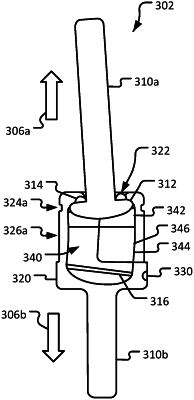| CPC A61B 17/7064 (2013.01) [A61F 2/4405 (2013.01); A61B 2017/00862 (2013.01); A61F 2002/3055 (2013.01)] | 7 Claims |

|
1. A facet joint replacement device, comprising:
a housing defining a cylindrical outer profile, an elliptical opening, and an internal space, wherein the internal space has a diameter that is larger than the elliptical opening, and wherein the internal space defines a longitudinal axis that is arced and is for replicating a natural trajectory of a healthy facet joint in extension and flexion;
a first rod slidingly engaged with the opening, the first rod being linear and including an internal end portion slidably disposed within the internal space and an external end portion disposed outside of the internal space, the external end portion and the internal end portion each having circular cross-sections, the internal end portion comprising a head with a head diameter greater than a diameter of other portions of the first rod; and
a second rod integrally affixed to and extending directly from the housing opposite the opening such that the second rod is immovable relative to the housing,
wherein the diameter of the internal space decreases as the housing extends away from a horizontal axis of the housing, and wherein the head is sized such that resistance to movement between the head and the housing increases as the head moves along the decreasing diameter of the internal space.
|